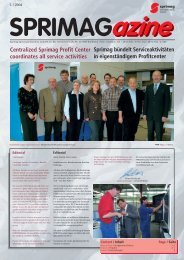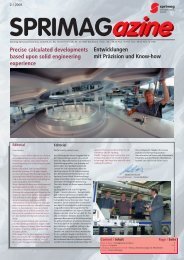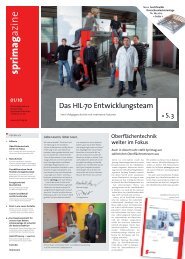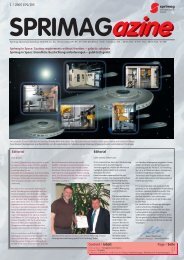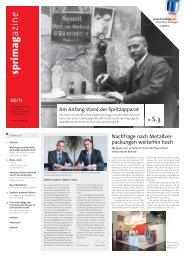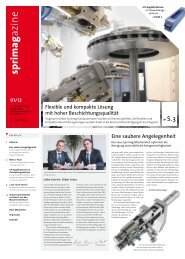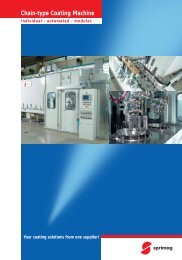Quality Management Certification- we have succeeded ... - Sprimag
Quality Management Certification- we have succeeded ... - Sprimag
Quality Management Certification- we have succeeded ... - Sprimag
Erfolgreiche ePaper selbst erstellen
Machen Sie aus Ihren PDF Publikationen ein blätterbares Flipbook mit unserer einzigartigen Google optimierten e-Paper Software.
4<br />
Flat Bed Spraying Plant to coat<br />
all surfaces of 3D plastic parts<br />
with water and solvent based lacquers – lacquer<br />
dried optionally by conventional or low temperature<br />
process<br />
SPRIMAG Flat Bed Spraying Plants are equipped<br />
with tough and proven systems which are especially<br />
designed for the rough requirements of lacquering<br />
applications. They offer many benefits to the customer<br />
and are considered as models within the lacquering<br />
application industry.<br />
As the standard version of the Flat Bed Spraying<br />
Plants cannot always meet the continuously increasing<br />
requirements of our customers and of the markets,<br />
a completely new machine concept to coat 3D<br />
plastic parts in one process has been developed.<br />
The basis for this application is an extremely flexible<br />
part-support transporting system, on which workpieces<br />
are delivered through all the application areas.<br />
Buffer zones for pallets, as <strong>we</strong>ll as a connection<br />
bet<strong>we</strong>en the main transport system and external<br />
production areas could also be incorporated without<br />
any problems.<br />
In order to reach an efficient drying cycle when processing<br />
water based lacquers, <strong>we</strong> <strong>have</strong> installed a<br />
conventional circulation air drier equipped with an<br />
electrical heating register combined with a low-temperature<br />
drier. A substantial reduction of the drying<br />
period, and therefore a reduced length of the equipment,<br />
could be achieved when improving the aerodynamics<br />
and working with a maximum temperature<br />
of 50° C and an atmospheric moisture of approx. 5%.<br />
Flächenspritzautomat zum<br />
allseitigen Beschichten von<br />
3D-Kunststoffteilen<br />
mit Wasser- oder Lösemittellack - Lacktrocknung<br />
wahl<strong>we</strong>ise konventionell oder Niedertemperaturverfahren<br />
Flächenspritzautomaten von SPRIMAG sind vielfach<br />
bewährte, robuste Systeme, die speziell für den rauhen<br />
Betriebseinsatz in Lackierapplikationen gebaut<br />
<strong>we</strong>rden. Sie bieten einen hohen Kundennutzen und<br />
gelten als Maßstab in der Lackierindustrie.<br />
Da die bekannten Standardversionen von Flächenspritzautomaten<br />
den stetig steigenden Kunden- und<br />
Marktanforderungen nicht immer gerecht <strong>we</strong>rden,<br />
wurde ein völlig neues Anlagenkonzept zum Beschichten<br />
von 3D-Kunststoffteilen in einem Durchgang<br />
entwickelt. Die Basis hierfür bildet ein äußerst<br />
flexibles Warenträger-Transportsystem, auf <strong>we</strong>lchem<br />
die Werkstücke durch die einzelnen Anlagenbereiche<br />
transportiert <strong>we</strong>rden. Pufferzonen für die Paletten,<br />
sowie eine Verbindung des Transportsystems mit<br />
externen Produktionsbereichen, sind hierbei problemlos<br />
möglich.<br />
Um bei der Verarbeitung von Wasserlacken eine<br />
möglichst effiziente Trocknung zu erzielen, wurde<br />
eine konventionelle Umlufttrocknung mit elektrischem<br />
Heizregister - kombiniert mit einem Kältetrockner -<br />
installiert. Bei einer Temperatur von max. 50° C und<br />
einer Luftfeuchtigkeit von ca. 5% sowie einer angepassten<br />
Strömungstechnik ließen sich die Trocknungszeiten<br />
und somit auch die Anlagenlänge<br />
<strong>we</strong>sentlich verkürzen.<br />
Projects<br />
Formula One in Internal Coating<br />
When Juan Manuel Fangio <strong>we</strong>nt for his fastest laps<br />
at Nürburgring in the sixties, SPRIMAG was already<br />
building Internal Coating Machines for pharmacy<br />
tubes and aerosol cans. At that time, capacity was<br />
approx. 60 to 80 units per minute. Today, the<br />
Schumacher brothers are performing their laps in<br />
times that nobody could <strong>have</strong> imagined before. The<br />
same could be said for the ne<strong>we</strong>st SPRIMAG units.<br />
When processing the highly sensitive aluminium<br />
tubes, currently production speeds commonly range<br />
from 150 to 180, even reaching up to 200 tubes per<br />
minute in some applications. Capacity development<br />
when processing monobloc aerosol cans is already<br />
in a range of 300 to 400 cans per minute. Last but<br />
not least, production lines for beverage cans are in a<br />
position to produce up to 2,400 cans per minute.<br />
These are typically produced using<br />
a „bank” of 8 to 9 single units with<br />
capacities of 325 each.<br />
Today’s focus of development at<br />
SPRIMAG is to upgrade capacity<br />
for the aerosol cans, independent<br />
of whether they are made of steel<br />
or aluminium. In production at a<br />
French company is the first working<br />
line with a capacity of 300 units<br />
per minute. Experiences gained<br />
with this line will be collected and<br />
implemented to benefit future generations<br />
of machines.<br />
The principle concept of the<br />
internal coating units is easy to<br />
explain. This process has already<br />
been used for many years, but<br />
capacity had been lo<strong>we</strong>r. During<br />
one working step each can is coated<br />
internally by a spray gun.<br />
Inside the spindle chain you will<br />
find supporting chucks (format<br />
parts) where cans are fed in with the open parts<br />
facing to the front. The spindle chain engages a star<br />
wheel at the spray station by means of a rotating<br />
quill shaft situated in the center, where 9 spray guns<br />
with nozzle extensions are installed. Each of these<br />
spray guns is inserted into the can with a spraying<br />
area of more than approx. 120°, and then being<br />
moved to evenly coat the internal sides of the rotating<br />
can. Thus each spray gun coats each 9th can.<br />
Afterwards the cans are automatically transmitted<br />
into the proven SPRIMAG curing oven.<br />
The „ aluminium magnet“, SPRIMAG has it in hand<br />
Most of the metals, except the noble metals, are<br />
subject to corrosion. And beverage cans are not<br />
excluded. To protect against corrosion is not a problem<br />
when using the SPRIMAG units. SPRIMAG<br />
Internal Coating Machines for aluminium and steel<br />
cans are fully developed and every day live up to the<br />
production expectations.<br />
Additionally, Outside Bottom Coating Machines for<br />
steel beverage cans are used to coat the dome, rim<br />
and chime in one working process without any problems.<br />
We <strong>have</strong> even successfully faced the challenge<br />
to coat an un-necked aluminium can. The requirements<br />
required exact handling and a high capacity<br />
(up to 800 cpm). The magnetic supports used for<br />
steel cans <strong>have</strong> been replaced with a vacuum chuck<br />
system to transport the aluminium cans during the<br />
coating process. The principle of coating outside<br />
bottoms is very similar to the above-described internal<br />
coating. Only two very important differences<br />
occur: On the one hand the spray guns do not carry<br />
out stroke movements, and on the other hand the<br />
coating is made by airless spray techniques.<br />
In case <strong>we</strong> <strong>have</strong> awaken your interest for these<br />
machines you could take the opportunity to<br />
inform yourselves about the convincing technology<br />
on "METPACK 2002” in Essen, 23rd to 27th<br />
April 2002 – see also show preview (page 7).<br />
We would be glad to <strong>we</strong>lcome you at our booth.<br />
Formel 1 der Innenbeschichtung<br />
Als Juan Manuel Fangio in den Sechzigern seine<br />
schnellen Runden auf dem Nürburgring drehte,<br />
baute SPRIMAG bereits Innenlackiermaschinen für<br />
Pharmazietuben und Spraydosen. Die Leistung pro<br />
Minute lag damals bei 60 – 80 Stück/Min. Heute fahren<br />
die Brüder Schumacher ihre Runden in Zeiten, die<br />
damals kein Mensch für möglich gehalten hätte. Dies<br />
gilt auch für die Maschinen von SPRIMAG.<br />
Bei den hochempfindlichen Aluminiumtuben gelten<br />
heute Produktionsgeschwindigkeiten von 150 – 180,<br />
teil<strong>we</strong>ise auch bis 200 Tuben/Min. als durchaus normal.<br />
Bei Monobloc-Aerosoldosen liegt die Entwicklung<br />
schon im Bereich von 300-400 Dosen/Min. Last<br />
but not least produzieren im Getränkedosenbereich<br />
die Linien bis zu 2400 Dosen/Min. Allerdings sind<br />
dort 8 bis 9 Einzelmaschinen mit einer Leistung von<br />
je 325 Dosen/Min. zu einer „Bank“ zusammengeschlossen.<br />
Der Sch<strong>we</strong>rpunkt<br />
der heutigen Entwicklung<br />
bei SPRIMAG liegt beim<br />
Leistungs-Upgrade in der<br />
Aerosoldosensparte —<br />
Aerosoldosen aus Stahl<br />
oder Aluminium. In einem<br />
Werk in Frankreich läuft die<br />
erste Linie mit Leistung<br />
300 Dosen/Min. Erkenntnisse<br />
daraus <strong>we</strong>rden gesammelt,<br />
umgesetzt und<br />
kommen der nächsten<br />
Generation zugute. Das<br />
Prinzip der Innenbeschichtung<br />
ist einfach: Jede Dose<br />
wird mit nur einem Spritzapparat<br />
in einem Arbeitsgang<br />
innenbeschichtet.<br />
Dieses Verfahren wurde<br />
bereits in früheren Jahren<br />
genutzt, allerdings für geringere<br />
Leistung. In einer<br />
Spindelkette befinden sich Haltefutter (Formatteile),<br />
in <strong>we</strong>lche die Dosen mit der Öffnung nach vorne eingeschoben<br />
<strong>we</strong>rden. Die Spindelkette umschlingt an<br />
der Spritzstelle ein Kettenrad mit einer rotierenden<br />
Hohl<strong>we</strong>lle im Zentrum, auf der 9 Spritzapparate mit<br />
Düsenverlängerungen angebracht sind. Jeder dieser<br />
Apparate fährt im Spritzbereich über ca. 120° in die<br />
Dose ein und lackiert während der Auswärtsbe<strong>we</strong>gung<br />
die rotierende Dose gleichmäßig innen aus.<br />
Jeder Spritzapparat lackiert demzufolge jede 9. Dose.<br />
Danach erfolgt die Übergabe in den bewährten<br />
SPRIMAG Einbrennofen.<br />
Der „Alu-Magnet“, SPRIMAG hat ihn<br />
Die meisten Metalle, außer den edelsten, neigen zur<br />
Korrosion. Davon sind Getränkedosen nicht ausgenommen.<br />
Davor zu schützen ist mit SPRIMAG-<br />
Anlagen kein Problem. SPRIMAG-Innenbeschichtungsmaschinen<br />
für Aluminium- oder Stahldosen<br />
sind ausgereift und bewähren sich täglich.<br />
Auch Außenbodenlackiermaschinen für Getränkedosen<br />
aus Stahl, mit denen Dome, Rim und Chime<br />
in einem Arbeitsgang beschichtet <strong>we</strong>rden, sind unproblematisch.<br />
Die Herausforderung liegt bei der<br />
ungeneckten Aluminiumdose. Exaktes Handling und<br />
hohe Leistung (bis zu 800 Dosen/Min.) sind gefordert.<br />
Vakuum ersetzt die Magnetkraft — sowohl während<br />
des Dosentransports als auch während des Beschichtungsvorgangs.<br />
Das Prinzip der Außenbodenbeschichtung<br />
ähnelt dem der oben beschriebenen Innenbeschichtung<br />
sehr stark. Z<strong>we</strong>i gravierende Unterschiede<br />
gibt es jedoch: Zum ersten führen die<br />
Spritzapparate keine Hubbe<strong>we</strong>gung aus und zum<br />
z<strong>we</strong>iten wird im Airlessverfahren beschichtet.<br />
Sollte Ihr Interesse an diesen Maschinen ge<strong>we</strong>ckt<br />
sein, können Sie sich von ihrer bestechenden<br />
Technik vom 23. bis 27. April 2002 auf der<br />
"METPACK 2002" in Essen selbst überzeugen<br />
– siehe auch Messevorschau (Seite 7).<br />
Wir würden uns freuen.



